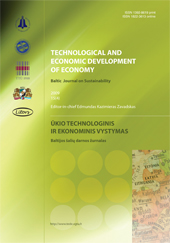Multicriterial Sustainability Assessment of Residential Buildings
Multicriterial Sustainability Assessment of Residential Buildings
Author(s): Roko Žarnić, Jana Šelih, Marjana Šijanec ZavrlSubject(s): Economy
Published by: Vilnius Gediminas Technical University
Keywords: residential building; construction quality; assessment method; decision method; sustainability indicators; labelling
Summary/Abstract: A simple method for the assessment of sustainability of a residential building is proposed. The method consists of two steps. First, areas that influence sustainability level of the building (e.g. building architecture, design, in-built materials) are identified. For each area, several elements and corresponding indicators are determined. Depending on their nature, the indicators are expressed either in quantitative or qualitative terms. The impact areas and their corresponding elements influence all three aspects of sustainability. In the second step, the indicators are aggregated according to their influence on individual sustainability aspects. Special attention is placed to the determination of weights assigned to the indicators in order to make the assessment method relevant in the local context. Initially, the consensus-based method within the research team was used as a technique for aggregated indicators’ weighting. Later, the open discourses among the developers and stakeholders, as well as surveys, were employed to determine the aggregated indicators’ weights. The proposed method is applied to a selected sample building, and the analysis of the results is carried out. The results obtained show that the completeness and reliability of the input data is crucial for the reliability of the proposed assessment method. Subjectivity in evaluators’ judgments required to score some indicators needs to be reduced by introducing adequate training of the assessors. The feedback from the potential users shows that the method has a potential for wider future implementation in practice.
Journal: Technological and Economic Development of Economy
- Issue Year: 2009
- Issue No: 4
- Page Range: 612-630
- Page Count: 19
- Language: English

